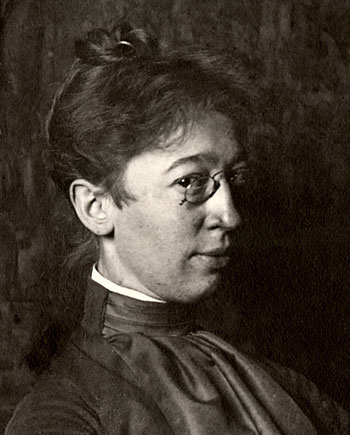Deerfield Arts & Crafts home page
People
Margaret C. Whiting
1860-1946

© Memorial Hall Museum, Pocumtuck Valley Memorial Association
Portrait of Margaret Christine Whiting, (detail) by Frances and Mary Allen, c. 1900.
Margaret Whiting, co-founder of the Deerfield Society of Blue and White Needlework was remembered as having "an astringent wit, an amused understanding, if not always tolerance, for her fellow man, and no one who spent five minutes with her could accuse of her of being inarticulate."1 It was, in large part, due to Margaret's confidence, business acumen, and unshakeable vision that for some thirty years surrounding the turn of the 20th century, Blue and White Society needlework was made to serve both profit and a cohesive artistic vision.
Having attended art school together in New York, Margaret Whiting and Blue and White Society co-founder Ellen Miller wrote and illustrated Wild Flowers of the Northeastern States, a botanical field guide published in 1895. The Whiting family moved to Deerfield, and Margaret and Ellen (who had moved with her family to town in 1893) began sketching the 18th-century embroideries they found at Deerfield's museum, Memorial Hall, and in private collections throughout the region. Soon the pair was designing embroideries inspired by colonial designs. A growing corps of local embroiderers executed the patterns, and the finished works were readily sold in Deerfield and beyond. A comparison of the prices of Blue and White Needlework with, say, the embroideries offered through the Sears, Roebuck and Company Catalogue makes clear that the Deerfield work would have been out of the reach of most consumers. Well aware of this fact, Margaret Whiting wrote about the reasons for it as early as 1901,
"We pay more for an idea than we do for a conscience! True art production--and here I speak with diffidence for this is my individual conviction strengthened only by my personal experience-lies in reckoning all degrees of labor employed. To an artist the payment the public gives him in money is, in his own estimation-the least of the rewards his work may win; yet it is the test to which his work must be brought.... And while it is true that a thing must be worth its price in order to obtain it, it is equally true that the price ought to be worthy of the thing in order that its maker may be encouraged to continue to produce."2
- Margery Burnham Howe, Deerfield Embroidery, (New York: Charles Scribner's Sons, 1976), 16.
- Margaret Whiting's notes on village industries and the DSBWN, c. 1901 Transcription of manuscript (Deerfield Town Papers, Box 1, Folder 9), PVMA Library.